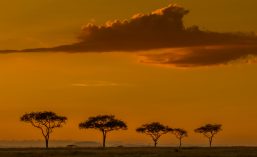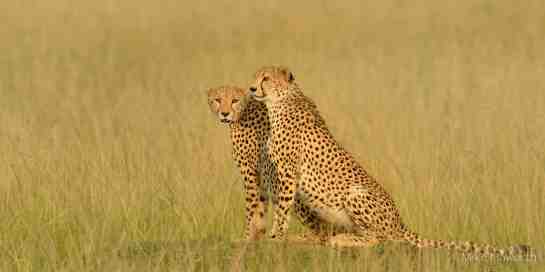It was not until third last day of our trip with CNP to the Masai Mara in early January that we saw our first Cheetah. The Mara is ideal Cheetah country with vast open spaces for these speedsters to really open up and use the competitive advantage. The next image shows the “dotted plains” with plenty of space for Cheetahs.
“Talent is never enough. With few exceptions the best players are the hardest workers.”
– Magic Johnson

The first afternoon we saw the Cheetah coalition they were on the slopes at the foot of the Oloololo escarpment. As visitors, it seemed unusual that they were working the steep rocky slopes rather than the grasslands. This male was perched on a anthill looking out from his vantage point.
The grass was much longer on these slopes than on the open grasslands of the plains. The change of environment made hunting more tricky and called for greater ambush tactics to catch the Impala and Oribis on the hillside.
We did not see the Cheetah coalition hunt on our first day. Two days later this Cheetah coalition were down on the grasslands in conservancy in front of Kitchwa Tembo camp. We first saw them under a Boscia in the open grasslands. The slightly blue tinge in the images is due to the shade. I did not want to colour correct it.

Earlier that day, we missed one of these Cheetahs taking down an Impala but they were quickly surrounded and robbed by the numerous Hyaena resident on the grasslands. The two males were licking the remaining blood off each other’s faces. Having lost their meal they were still hungry.

A closeup of these two males cleaning each other. The co-operation was evident.
Cheetahs have a distinct black “tear mark”, which runs from the inside corner of the eye down to the side of the mouth. These dark “tear marks” reduce glare from the bright sun, improving their already excellent vision. Binocular vision is a very important asset since Cheetahs rely on sight to hunt as opposed to scent, given the distance involved. The retinal fovea of the eye is an elongated shape, giving a sharp, wide-angle view. This aspect of the eye is also adapted for speed. You can imagine how it must sting when you are moving through the grass at 120 kilometres per hour.
The light frame of these Cheetah males emphasis their speed rather than enormous bite power which you find in a Lion or Hyaena. 
Having duly demarcated his territory, this male had spotted something interesting in the distance which seemed worth investigating.

Everything about the frame of this animals indicates speed.
Look how proportionally big the Cheetah’s chest is to house its out sized lungs and heart. Its waist is the envy of many slimmers. Its legs are also proportionately large for its body. Those back legs are huge compared to their head. Everything about a Cheetah is built for speed.

The Cheetah males were walking along a sand track when they suddenly saw two Impala arms in the distance. Immediately their demeanor changed. They moved into the grass for better camouflage. They would stop and crouch every time the Impala looked up from grazing and would move closer as the Impala lowered its head to graze.
“There are only two options regarding commitment. You’re either IN or you’re OUT. There is no such thing as life in-between.”
– Pat Riley

According to http://bigcatrescue.org/, the Cheetah’s resting heart rate is approximately 120-170 beats per minute, and it’s heart rate after a chase can be between 200 and 250 beats per minute. The Cheetah’s resting breaths vary from 20-30 per minute depending on whether the Cheetah is in direct sunlight or in the shade. After a chase the Cheetah’s breaths per minute can be 150-200.
Once these Cheetahs got to within about thirty metres of the Impala with their heads down in the grass, these dragsters opened their turbos. It is actually really tricky getting good images of the Cheetah running at full speed.
A stride is the measured distance between successive imprints of the same paw. With the added reach given by the spine, one stride can span 7-8 metres. The Cheetah averages four strides per second compared to the average 2.3 horse strides per second.

The Cheetah’s tail is an effective counter balance and rudder in high speed chases. On this occasion their hunting tactic did not work. The Impala were grazing next to a lugga. This must have been a old excavation left over from road building next to the river. As soon as the Impala saw the Cheetah hurtling towards them they dashed down into the lugga which broke the Cheetah’s speed advantage and they managed to get away unscathed.
“If you have everything under control, you’re not moving fast enough.”
– Mario Andretti

The Cheetah is a very vocal animal. It has the ability to mimic the calls of some birds, using a high pitched chirping sound. According to http://www.cheetah.org, coalition partners are very tolerant of one another’s close proximity, spending over 50% of their time in contact or less than one metre apart. They rarely separate and call continuously for each other when they do.
Having missed the two Impala the Cheetah males decided to move back up to the slopes of the Oloololo escarpment. Perhaps its was too hot in the grasslands with too many Lion and Hyaena to contend with.
The Cheetah were very obliging and walked on a ridge. This provided the perfect perspective and background.
Cheetah are very weary. They would walk for a while and at a suitable vantage point would stop and have a good look around presumably for both prey and predators.
“If you want to go fast, go alone. If you want to go far, go together.”
– African proverb
Both males were in good condition.
Having found a suitable look out, they both lay down in the sun to have a look around. They were well camouflaged when lying on the ground.
Cheetah’s ears are relatively small suggesting that sight is their primary sense.
When cheetahs display social behaviour, their greeting ceremony is limited to sniffing, face-licking, and cheek-rubbing. They do not body rub like lions.
Cheetahs groom each other mainly after meals when their faces have blood on them or after a rainstorm when their coats are wet. Cheetahs purr most often during grooming.
The Cheetah’s long tail acts as a counterbalance when it has to make sharp twists and turns while chasing its prey. The tail is vertically elongated to act as a rudder when moving at high speed.
It is quite something to see two wild animals co-operating like this. Another sign of natural intelligence.
In the wild, few cheetahs survive longer than seven or eight years, though they can live to 10 or 12 years. Males tend not to get to old age. Less than 50% survive to old age as a result of fighting over territorial and mating rights. There is generally a higher ratio of adult females to males in wild populations.
The wild Cheetah population, as reported by http://www.Cheetah.org, in 1900 was approximately 100,000 in 44 countries throughout Africa and Asia. In the last 20 or more years, the population has declined by 30% and the human population has doubled. Today, the total known population is estimated at 7,500 mature breeding individuals and the unknown populations may raise the total to no more than 10,000. Their population numbers were last assessed by the IUCN in 2008.
“Many a trip continues long after the movement in time and space have ceased.”
– John Steinbeck
Explore, seek to understand, marvel at its inter-connectedness and let it be.
Have fun,
Mike


















Just love the images and interaction – each image tells a story. Well done, Mike!